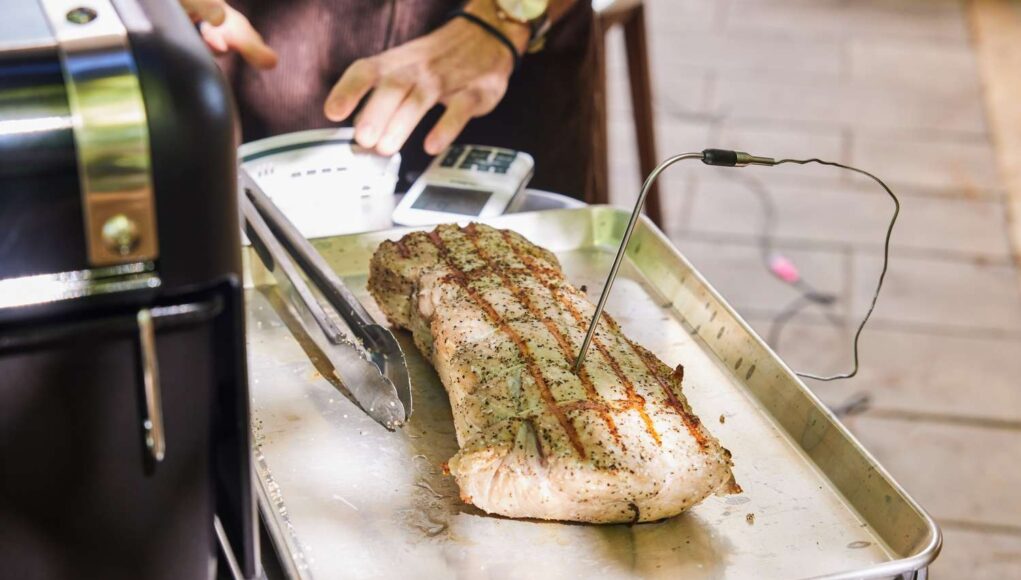Where to put the meat thermometer in a brisket is essential knowledge for anyone passionate about barbecue and grilling. Proper placement ensures that your meat is cooked to perfection, providing both safety and enhanced flavor.
Placing a meat thermometer correctly in a brisket guarantees accurate readings. This avoids undercooking and overcooking and allows you to serve a delicious, safe meal. It’s crucial to get this right, particularly when preparing large cuts like brisket.

The Ideal Placement of a Meat Thermometer in a Brisket
The Point Cut vs. The Flat Cut
Brisket consists of two main parts: the point cut and the flat cut. Understanding the difference between these two cuts is vital for proper thermometer placement.
The point cut has more fat and is located closer to the chest, whereas the flat cut is leaner and lies along the bottom of the brisket. Each cut requires different attention when inserting a thermometer.
Why the Thickest Part?
Insert the thermometer into the thickest part of the brisket for the most accurate readings. The thickest part of a brisket usually lies within the flat cut. This method ensures you measure the meat’s core temperature, leading to better results.
Avoiding Bone Contact
A common mistake is inserting the thermometer probe too close to the bone. This results in inaccurate temperature readings since bones conduct heat differently than meat. Always aim for the meat’s center, avoiding bones and gristle.
Using Multiple Thermometers
For large briskets, consider using multiple thermometers. This provides a more comprehensive understanding of the internal temperatures across different sections. By doing this, you can ensure every part of the brisket is cooked evenly.

Types of Meat Thermometers for Brisket
Instant-Read Thermometers
Instant-read thermometers are fantastic for quick checks. They provide fast and accurate readings, ideal for intermittent temperature checks.
Leave-In Thermometers
Leave-in thermometers allow continuous monitoring without repeatedly opening your grill or smoker. They are ideal for slow-cooking methods often used when preparing briskets.
Bluetooth and Wi-Fi Thermometers
Modern technology has brought more convenience with Bluetooth and Wi-Fi thermometers. These allow you to monitor your brisket’s temperature remotely, providing alerts and graphs through a smartphone app. This innovative approach ensures you can enjoy social gatherings without constantly checking your smoker or grill.

Common Mistakes to Avoid
Inserting Too Late
One common mistake is inserting the thermometer too late in the cooking process. It’s best to place the thermometer early to monitor the temperature from start to finish.
Not Calibrating the Thermometer
Always calibrate your meat thermometer before use. Miscalibrated thermometers can lead to inaccurate readings, jeopardizing your brisket’s quality.
Ignoring Carryover Cooking
Remember that meat continues to cook after being removed from the heat source. Factor in carryover cooking and remove the brisket slightly before reaching the target temperature.
FAQ
What is the target temperature for a brisket?
The ideal internal temperature for a brisket is typically around 195-205F. This range ensures tenderness while keeping the meat juicy.
How far should I insert the thermometer?
Insert the thermometer probe at least 1-2 inches into the thickest part of the brisket but avoid going all the way through.
Can I use any meat thermometer for brisket?
While you can use standard meat thermometers, investing in high-quality, leave-in, or digital thermometers provides the best results for brisket.
Additional Resources
For more detailed information on using meat thermometers, you can visit Good Housekeeping’s Guide.
For more awesome grilling tips, check out articles on how to season a griddle and pairing rotisserie chicken!
As an Amazon Associate, I earn from qualifying purchases.








